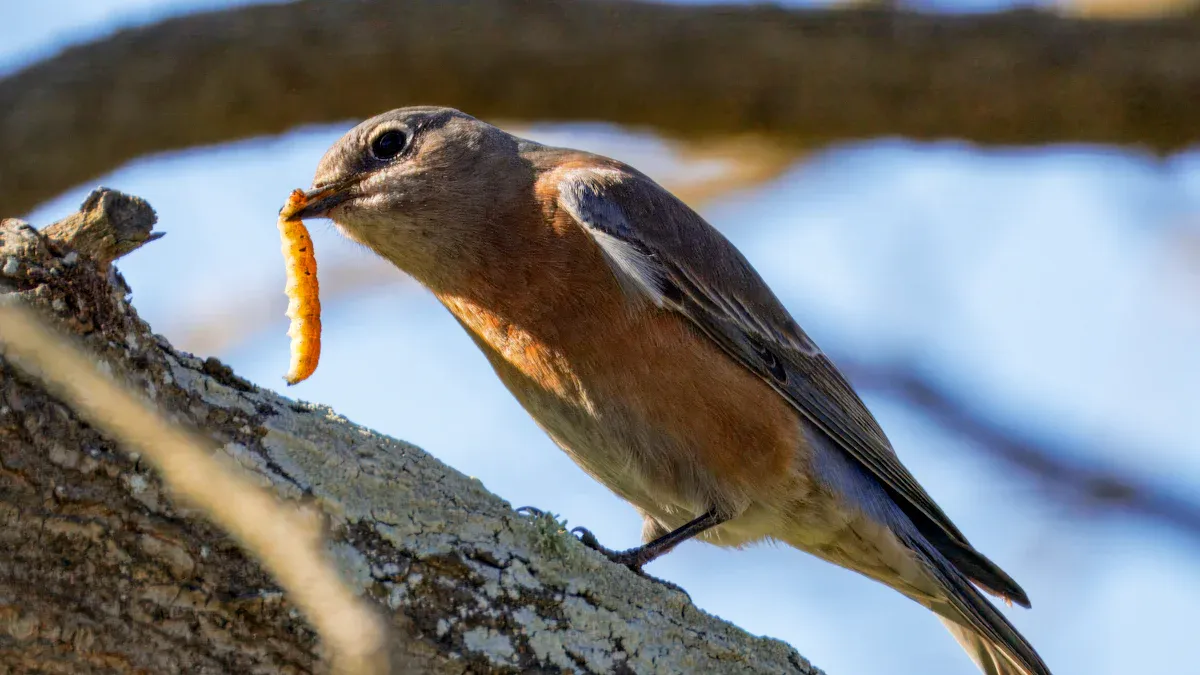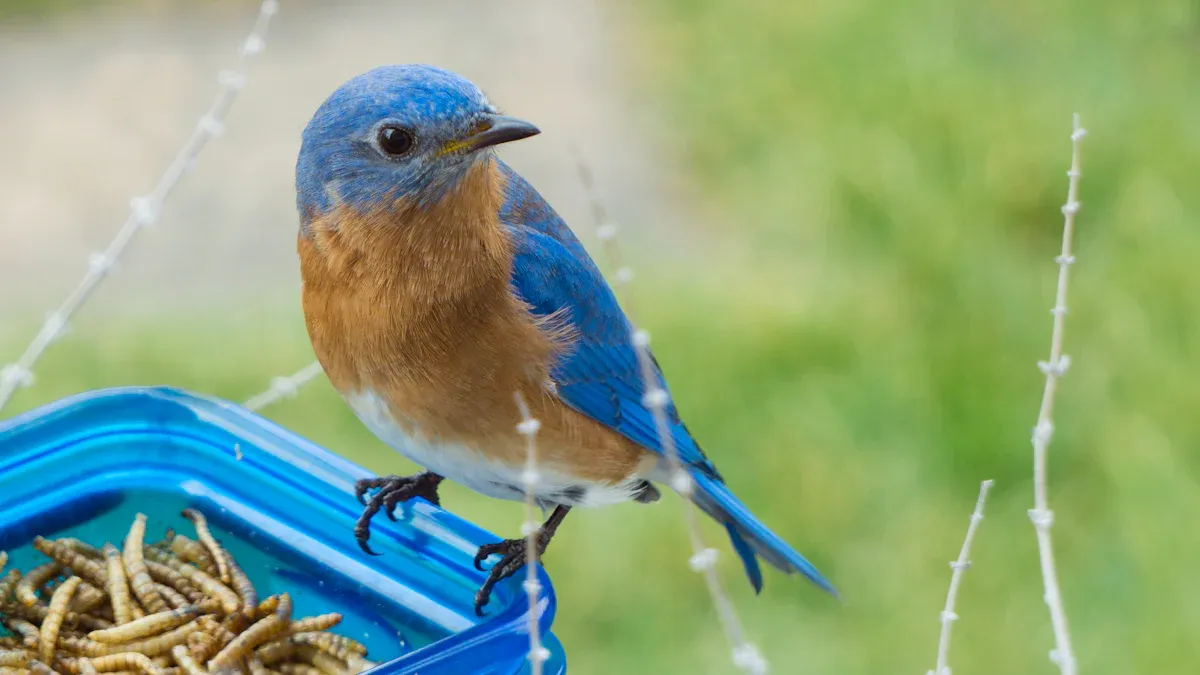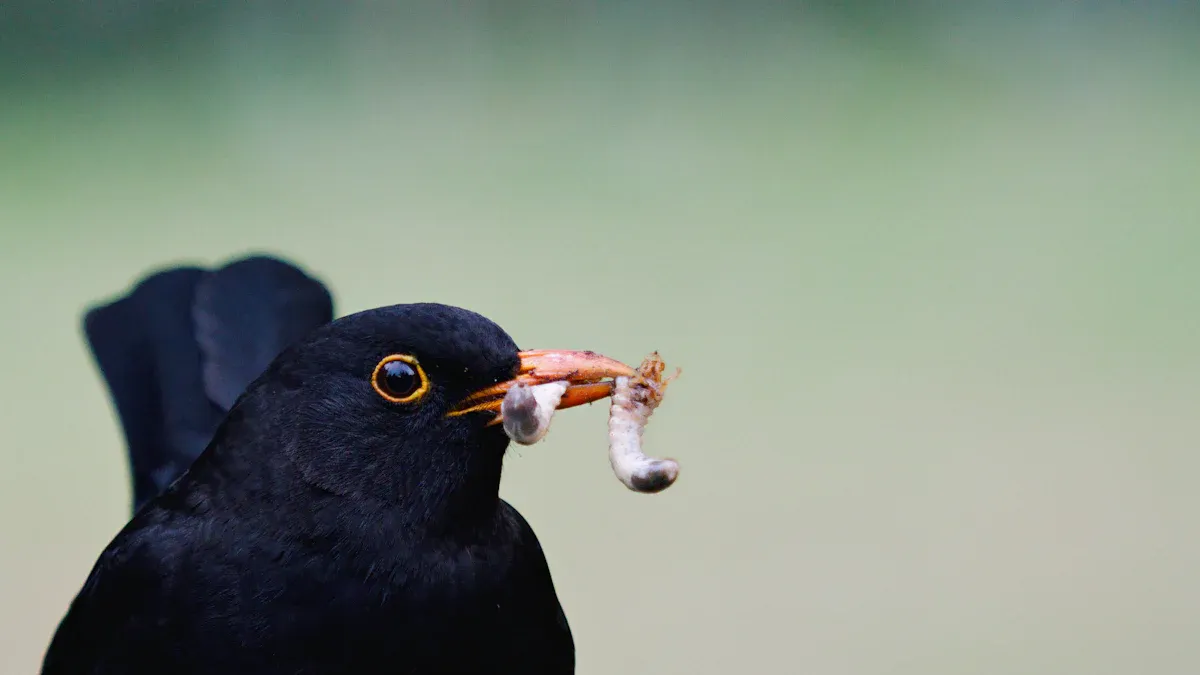
Birdwatching becomes more exciting when the backyard is alive with activity. Freeze dried mealworms for birds offer a simple way to draw in feathered visitors. These protein-packed treats help birds stay healthy and energetic. Robins, sparrows, and other species flock to feeders stocked with mealworms, making birdwatching a delightful experience.
Tip: Freeze-dried mealworms are an excellent choice for those who prefer not to handle live food. They’re mess-free and easy to store.
Key Takeaways
- Freeze dried mealworms are healthy for birds. They give protein and energy, which birds need during nesting and migration times.
- Putting out freeze dried mealworms brings many types of birds to your yard. This makes birdwatching more fun with lots of action and different birds.
- Keep mealworms fresh by storing them in sealed containers. Place feeders in good spots so birds can easily find the food.
Benefits of Freeze Dried Mealworms for Birds and Birdwatchers

Nutritional Value and Health Benefits for Birds
Freeze dried mealworms for birds are packed with protein, making them an excellent food source for garden birds. Protein helps birds stay strong and active, especially during demanding times like nesting or migration. In spring, parent birds need extra energy to build nests, lay eggs, and care for their chicks. Mealworms provide the nutrients they need to thrive.
Winter brings its own challenges. Bugs and worms become scarce, leaving birds searching for alternative protein sources. Freeze dried mealworms offer a reliable solution. They’re easy to store and serve, ensuring birds get the nutrition they need year-round. Robins, sparrows, and other species love them, making your backyard a hub of activity.
Tip: Robins are especially fond of mealworms. Adding them to your feeder can make your birdwatching experience even more rewarding.
Eco-Friendly and Sustainable Feeding Option
Freeze dried mealworms for birds aren’t just good for wildlife—they’re good for the planet too. Producing mealworms requires fewer resources compared to traditional livestock farming. Studies show that mealworm production generates significantly lower greenhouse gas emissions and uses less energy than raising chickens. This makes them a sustainable protein source for birds.
Although the freeze-drying process uses energy, the overall environmental impact of mealworm production remains much lower than conventional farming methods. By choosing freeze dried mealworms, birdwatchers can support eco-friendly practices while helping their feathered friends.
Attracting a Diverse Range of Bird Species
Mealworms are a favorite among many bird species. From robins to bluebirds, they appeal to a wide variety of backyard visitors. Their high protein content makes them irresistible, drawing in birds that might not usually visit your feeders.
Adding freeze dried mealworms to your feeding station can transform your birdwatching experience. You’ll see more species, hear more songs, and enjoy the vibrant activity of birds flocking to your yard. Whether you’re a seasoned birdwatcher or just starting out, mealworms are a simple way to attract a diverse range of birds.
Note: Mealworms are also a healthier alternative to bread when feeding ducks at your local pond.
Practical Tips for Using Freeze Dried Mealworms for Birds

Choosing the Best Feeder for Mealworms
Selecting the right feeder ensures birds can easily access the mealworms while keeping them safe and secure. Feeders with tall sides work best for holding freeze dried mealworms, as they prevent the worms from being blown away by the wind or spilling out. Adding a roof or rain guard protects the mealworms from getting wet, which helps maintain their freshness. Drainage holes are another useful feature, as they prevent water from pooling inside the feeder during rainy weather.
For birdwatchers who want to attract a variety of species, platform feeders or tray feeders are excellent options. These feeders provide an open space that accommodates birds of all sizes, from small sparrows to larger robins. Hanging feeders with perches are also a great choice, especially for birds that prefer to feed off the ground.
Tip: Always clean feeders regularly to prevent the buildup of mold or bacteria, ensuring a safe feeding environment for your feathered visitors.
Ideal Placement of Feeders for Maximum Visibility
Where you place your feeder can make a big difference in attracting birds. Birds feel safer when feeders are near protective cover, such as shrubs or trees, where they can quickly retreat if predators appear. However, placing feeders too close to trees or structures can invite unwanted guests like squirrels or raccoons. A good rule of thumb is to position feeders far enough away to deter predators but close enough to provide birds with a sense of security.
To prevent bird collisions with windows, place feeders either within 5 feet of a window or at least 30 feet away. This reduces the risk of birds flying into the glass. Additionally, consider the direction of prevailing winds and sun exposure. A sheltered spot with some sunlight creates a comfortable feeding environment for birds.
- Key placement tips:
- Keep feeders within 5 feet or at least 30 feet from windows.
- Position feeders near shrubs or trees for safety.
- Avoid placing feeders too close to predator-prone areas.
Note: Observing bird behavior in your yard can help you adjust feeder placement for the best results.
Introducing Mealworms to Birds Effectively
Introducing freeze dried mealworms to your backyard birds requires a bit of strategy. Birds may initially hesitate to try something new, so making the mealworms more appealing can help. Soaking them in lukewarm water softens their texture and enhances their scent, making them more enticing. For birds unfamiliar with freeze dried mealworms, offering live mealworms briefly can encourage them to try the dried version later.
Moistening the mealworms is especially effective during nesting season, as parent birds often prefer softer food for their chicks. However, avoid leaving damp mealworms out for more than a couple of days to prevent spoilage.
| Observation | Result | Notes |
|---|---|---|
| Nesting success | Increased hatching success | Observed across years and geographic range |
| Resistance to parasites | Higher resistance to blow flies | Measured via antibody response |
| Geographic variation | Effects varied by year | Blow fly abundance fluctuated across years |
Using feeders designed specifically for mealworms can also improve the experience. Feeders with tall sides and drainage holes keep the mealworms secure and fresh. Including a roof or rain guard adds extra protection from the elements.
Tip: Start with small amounts of mealworms to gauge bird interest and gradually increase the quantity as more birds visit your feeder.
Seasonal and Situational Use of Freeze Dried Mealworms
Feeding Birds During Nesting and Migration Seasons
Birds face some of their toughest challenges during nesting and migration. Freeze dried mealworms for birds provide the perfect energy boost during these demanding periods. Packed with approximately 45% protein and 33% fats, they deliver the nutrients birds need to thrive.
During migration, birds rely on fat stores to fuel their long journeys. Mealworms contain essential fatty acids like 18:1, 18:2, and 18:3, which help build these reserves. Nesting season also demands high energy. Parent birds need extra protein to build nests, lay eggs, and feed their chicks. Adding mealworms to feeders during these times can make a big difference in their success.
Tip: Offer mealworms in the early morning or late afternoon when birds are most active and searching for food.
Adjusting Feeding Habits Based on Weather Conditions
Weather plays a big role in how birds feed. Rain and high temperatures often increase the removal of mealworms from feeders, especially in the afternoons. Wind direction can also influence feeding patterns, with certain winds making birds more active in the mornings.
To adapt, place feeders in sheltered areas during windy days and ensure mealworms stay dry during rain. A covered feeder or one with drainage holes works best. Observing how weather affects bird activity in your yard can help you adjust feeding times and locations.
Year-Round Benefits of Freeze Dried Mealworms
Freeze dried mealworms aren’t just seasonal—they’re beneficial all year. In winter, they provide a concentrated source of energy when natural food is scarce. In spring and summer, they support nesting and chick development. Studies show that birds consuming mealworms experience better growth, stronger bones, and improved egg quality.
By offering mealworms consistently, birdwatchers can enjoy a lively backyard filled with healthy, active birds throughout the year.
Sourcing and Storing Freeze Dried Mealworms
Where to Find High-Quality Mealworms
Finding reliable suppliers for freeze dried mealworms ensures birds receive the best nutrition. Several trusted vendors specialize in high-quality mealworms, offering products that meet strict standards for bird feeding.
| Supplier Name | Link |
|---|---|
| NINGBO ANSHENG HARDWARE CO LTD | Profile |
| AIXIN INTERNATIONAL INDUSTRIAL | Profile |
| JINAN HONG SHUN INSECTS CO LTD | Profile |
Mealworms are gaining popularity as sustainable protein sources due to their lower environmental impact compared to traditional livestock. They’re rich in protein and essential nutrients like iron, vitamin D, and zinc, making them ideal for supporting bird health.
Tip: Choose suppliers with a proven track record of quality control to ensure your freeze dried mealworms for birds are safe and nutritious.
Proper Storage Techniques to Maintain Freshness
Proper storage keeps freeze dried mealworms fresh and nutritious for longer periods. Moisture is the biggest enemy of mealworms, as it can lead to microbial spoilage. To prevent this, store mealworms in airtight containers in a cool, dry place.
Refrigeration can help retain their sensory properties, but it’s only effective for short-term storage. For long-term use, ensure the moisture content is reduced to levels between 0.87% and 9.83%. This prevents spoilage and maintains nutritional quality.
Note: Studies confirm that drying methods play a crucial role in reducing moisture content, making freeze dried mealworms suitable for extended storage.
Common Mistakes to Avoid When Storing Mealworms
Avoiding common storage mistakes ensures mealworms stay fresh and safe for birds. Here are some pitfalls to watch out for:
- Exposing mealworms to moisture: Always use airtight containers to keep humidity out.
- Storing in direct sunlight: Heat can degrade the nutritional quality of mealworms.
- Using preservatives: Research shows that preservatives don’t enhance shelf life and may affect the mealworms’ quality.
By following these guidelines, birdwatchers can ensure their freeze dried mealworms remain a reliable food source for backyard birds.
Freeze dried mealworms for birds offer a sustainable and nutritious way to enhance birdwatching. They attract diverse species while supporting bird health. Mealworms boast high feed conversion efficiency and essential nutrients like amino acids and beneficial fats. Start using them today to create a lively, bird-friendly backyard filled with vibrant activity.
Fun Fact: Mealworms can even improve the nutritional quality of wheat bread without compromising safety!
FAQ
What types of birds enjoy freeze dried mealworms?
Robins, bluebirds, sparrows, and even wild ducks love them! These protein-packed treats attract a wide variety of backyard birds, making your feeders a lively spot. 🐦
How should I store freeze dried mealworms?
Keep them in an airtight container in a cool, dry place. Avoid moisture and direct sunlight to maintain freshness and nutritional quality.
Can I feed freeze dried mealworms to ducks at the pond?
Absolutely! Mealworms are a healthier alternative to bread. Ducks enjoy them, and they provide essential nutrients without the risks associated with feeding bread. 🦆
Tip: Start with small amounts to see how birds or ducks respond, then adjust based on their interest.


